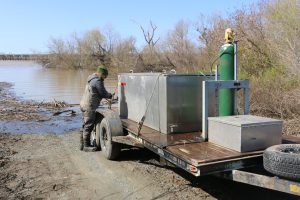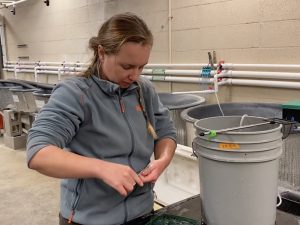It has been about six weeks since we concluded our fieldwork and drained our Ricelands Salmon Project field. Our primary objective was to practice the draft salmon management practice on a full-sized rice field and assess the extent to which natural-origin or “wild” salmon used the 125-acre Sutter Bypass rice field after the floodwaters had receded. A special shout-out goes to Steve Neader for the use of his fields and his continued willingness to devote his time and energy into helping to us to test-out the draft management practice.
We counted 389 wild salmon, likely representative of all four runs. However, we must wait for genetic results to confirm how many of each run we collected. Due to a second bypass flood event in mid-March, we were unable to drain the whole field and count every fish as they exited the field. However, based upon the capture of nearly 400 wild salmon, we estimate there were at least 4,000 wild salmon that used the project field and probably much more. These are very exciting results.
This field season’s fieldwork, with near perfect bypass flooding conditions, enabled us to demonstrate our ability to safely implement the management practice with federally-listed runs of salmon (winter- and spring-run) in the field. Using an additional 4,500 PIT-tagged hatchery salmon, we also replicated previous years’ results by demonstrating that the fish moved freely through all checks of the field using the specially-modified rice boxes allowing for fish passage.
We and the UC Davis team of scientists working the project continue to track our specially-tagged salmon as they are moving through the lower Sacramento Valley, in route to the ocean. Of the 462 tagged fish released, nearly 30 percent have made it out to the San Francisco Bay as of the date of this report.
Recently, KPIX CBS News Bay Area featured CRC’s Environmental Affairs/Ricelands Salmon Project Manager Paul Buttner and UC Davis researcher Andrew Rypel in a TV news story.
WATCH: Researchers raising salmon in rice fields to save dwindling population

Weekly field reports, videos, pictures and a link to CalFishTrack can be found at the Ricelands Salmon Project website: Ssalmon.CalRice.org/field-news/
Finally, we want to thank our major funders—USDA’s Natural Resources Conservation Service, Syngenta, State Water Contractors—and many other supporting project sponsors listed on the project website for making this project possible.



